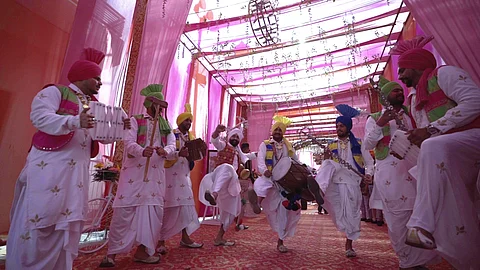

Bhangra is synonymous with Punjab and vice versa, there is no doubt about it. The dance form has gone wherever Punjabis have gone, including Canada and the UK, and is being taught there as well. But there is more to Punjabi folk dance than Bhangra, no matter what Bollywood would have you believe. So out to show the world the many folk dances The Land of Five Waters holds close to its heart, the documentary The Project Punjab is almost here.
Because Rajveer Kaur was based out of Hyderabad as a child, her true blue Punjabi parents were all the more insistent that they make that annual trip to Nawanshahr in Punjab every summer. But this was not the be all and end all of it. Apart from speaking in Punjabi, they were exposed to Punjabi culture via literature as well. In the later years, the former PR professional was back in Punjab in 2017 to attend a wedding. And is usual for Punjabi weddings, singing and dancing was an integral part. "My cousins suggested that we call a group from Bhatinda who performed Malwai Giddha and that's when it all began," she explains.
Malwai Giddha, a folk dance from the Malwa region of Punjab, was originally known to be performed by Babey (old men) and was also referred to as Babeyan da Gidhha. But now it involves young men too. The lyrics are all about teasing, about day-to-day-life, current affairs and even just banter. The steps are spontaneous and simple. Rajveer was so piqued by this that she started research on other folk dances she might not know about. "I found that there are as many as 42 folk dances in Punjab and very few of them are documented properly," she says. And that's when the idea of The Project Punjab began to form.
When Rajveer travelled to Mumbai and discussed the idea of the documentary with her friend, Harshbir Phull, he was ready to come on board with his expertise as a Director of Photography. Rajveer got in touch with North Cultural Zone in Patiala and they connected her to many others all eager to help out and as if united by the mission that yes, it's time for Punjab's other folk dances to claim their spot in the sun. Many people came forward to help her connect with the right contacts. Thus, she decided to travel to every village and every city that she could to document the dance forms in their purest form.
In January 2019, the duo travelled to document jhoomar, which literally means sway. It's all about adapting the movements of animals and is slow and rhythmic in nature. "Usually, men stand in a semi-circle and one person takes center-stage, then goes back and another man comes and the goes on. It is performed on happy occasions like after harvesting or marriages," explains Rajveer. They even travelled to Lovely Professional University where students were using these dance forms to perform on cultural days.
"There is a massive disconnect because no one teaches this during our childhood. There are classes for Bhangra, but what about these art forms? We need to watch, learn and appreciate them," implores Rajveer. The Project Punjab, the first series which will feature 10 dance forms, will positively release by the end of the year and Rajveer hopes that she can continue to shed more light on the lesser-known dance forms of Punjab.
Some dance forms you might not know about:
- Luddi: Performed to celebrate any victory. Men usually wear kurtas and a loincloth to go with their turban. While one hand is placed on the back, the is waved in the air, mimicking a snakes movement and this is the signature step
- Sammi: Originating from the tribal communities of West Punjab, this dance form is performed by women too. It's existence is threatened because it is known only to women of displaced tribes
- Nachaar: Young boys dress as girls and various instruments like chimta or dhol are used. This dance is usually practiced by boys in those villages that are around cantonments
For more on them, check out instagram.com/theprojectpunjab
